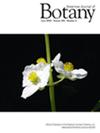Herbivory exacerbates pollen limitation by isolating unconsumed plants from prospective mates
Abstract
Premise
Herbivores directly influence plant reproduction by damaging reproductive tissue which reduces seed production in consumed plants. Consumption of reproductive tissue may also indirectly depress reproduction in unconsumed plants by isolating unconsumed individuals from prospective mates and reducing pollination. However, empirical support for such hypothesized indirect effects remains limited.
Methods
To investigate potential indirect effects of herbivory on mating opportunities and pollination, we quantified spatial patterns of white-tailed deer (Odocoileus virginianus) herbivory and reproductive outcomes in Lilium philadelphicum (Liliaceae). We mapped 708 flowering plants, monitored deer herbivory, and examined how distance to prospective mates influenced rates of ovule fertilization, a proxy for pollen receipt.
Results
Most flowering L. philadelphicum plants (83%) failed to produce seed. Deer consumption of flowers prevented seed production in 35% of individuals. The probability of deer herbivory declined with distance to flowering conspecifics. Sixty-five percent of the remaining, unconsumed plants failed to produce seed due to apparent pollen limitation. While ovule fertilization rates declined with multiple predictors quantifying distances to flowering conspecifics, isolation metrics that excluded plants consumed by deer significantly improved predictions of ovule fertilization.
Conclusions
Our results offer empirical support for the hypothesis that herbivory reduces pollination and seed production in unconsumed plants by altering spatial mating opportunities. This feedback between deer herbivory and distance-dependent pollination contributes to widespread reproductive failure in L. philadelphicum, though the extent to which deer reduce seed production varies with plant isolation. Herbivory may exacerbate pollen limitation in other species by isolating unconsumed plants from prospective mates.

 求助内容:
求助内容: 应助结果提醒方式:
应助结果提醒方式:


